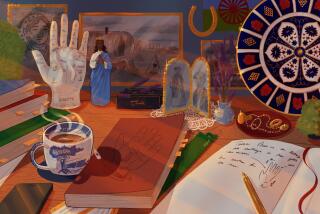Getting a Bead on Anxiety and Greek Culture
- Share via
“They’re plastic,” Aris Evangelinos said as he snatched the worry beads from my husband’s hand and put a match to them. The orange and yellow beads were wrapped in flames. Evangelinos waited a moment, put his nose to the beads and sniffed. I scanned their edges. Plastic would melt; amber would burn. Peter’s komboloi did neither.
Evangelinos, founder and curator of the Komboloi Museum in Nafplion, Greece, was uncertain. Peter’s mood improved immediately.
I had bought Peter the strand of Greek worry beads as a gift a week earlier in Crete, and since then we had been worrying whether it was the objet d’art we had been told it was.
Evangelinos lighted another match. The flames lingered.
“Well,” I asked before he could light a third, “what are they?”
Peter’s beads were not the standard olive wood or monochromatic plastic. They looked like geologic tie-dye--with layers of red and orange with sepia swirls and bursts of sunset. The beads, we had been told in the small shop where we bought them, were a mixture of amber and stone from China.
“Plastic,” declared the owner of our hotel in Crete when he saw them. He pulled from a pocket his own komboloi--deep red, as if cut from a glass of claret sitting in the sun. “Amber,” he said, his fingertips passing lightly across a couple of beads, “from the Komboloi Museum in Nafplion.”
In the past few hundred years, the Greeks have transformed worrying from a pedestrian experiment to high art. Komboloi have all but cured anxiety. In many countries beads are associated with prayer, but on the streets of contemporary Greece, komboloi supply calm companionship and a certain chic. Worrying them is colorful, rhythmic, sensuous.
Peter wanted them. He wanted to grasp the whirling or slow, drip-dripping komboloi he heard everywhere in Greece. They ticked and twirled in the hands of restaurant patrons waiting for tables. They sighed in the hands of salesmen tending empty shops. They wrapped around young and old fingers alike. Beads dropped slowly, one at a time, through the fingers, rapping softly but resoundingly on the bead below.
You could find rhythms for every mood, lengths for every hand, beads for every budget. All these rhythms combined sounded like the collective pulse of Greece.
Komboloi, traditionally a male distraction, caught my attention too. There was something appealing about this ancient, compact, aesthetic, low-tech antidote to Palm Pilots, cell phones and Internet access anywhere, any time in the split-second timing of the 21st century. Stroking beads sends a message to the brain that’s different from jabbing at keyboards; its even rhythms unlock a portal to a place light-years from the office.
Our search to decipher Peter’s beads led us to Nafplion and Aris Evangelinos.
The Komboloi Museum is a candy store for the anxious. One wall is covered to the ceiling in strands of cabernet red, amber orange and saffron yellow beads. Smooth to the touch, they feel like poetry to the fingertips. Some are translucent, others built of so many layers that the eye loses its way before the center is discerned.
In this tree- and fortress-filled seaside town on the eastern edge of the Peloponnese, Evangelinos repairs older komboloi and sells contemporary versions of traditional designs. Hanging on the back wall are black-and-white photos of a komboloi workshop in Egypt, and the first Greek workshop to make the beads. Upstairs is a museum of rosaries and prayer beads that Evangelinos has collected during his travels for more than 20 years.
Unfortunately, Peter and I did not make a good first impression. We arrived with komboloi of questionable quality, and we were obviously too ignorant to be buyers of consequence.
I retreated up a narrow, well-worn staircase to the museum, four small rooms of beads--Hindu, Buddhist, Muslim, Christian and Greek, most dated from 1750 to 1950. Made from red and black coral, cedar and sandalwood, glass, Bakelite, snake’s bone or mother-of-pearl, some strands held as few as 19 beads, others more than 100. Most surfaces were smooth, but a few had intricately carved or etched designs. A single, rare strand of Tibetan beads made from horn hung next to three strands of black coral mixed with ivory, silver and amber, and a length of Chinese beads carved from elephant bone. Amber was clearly the material of choice: There were more than a dozen strands of beads, crimson and rust, gold and flaxen, cherry and brick.
By the display of Greek komboloi was a typed sign that read: “The only country in the world that never uses a komboloi for religious purposes. We have take this habit from the Turks (Moslems). We made it little bit different than originally was, and it became like a toy in our hands helping us to calm and also to have something to concentrate and gather.” Perplexed grammarians passing through had crossed out certain words and written in others. “The number of the beads is not specified. It depends on the size and the length related to the size of the hand. The total number of the beads has to be an odd one.”
I spent more than an hour studying the beads, the signs and the editing. I also flipped through the book Evangelinos had written and published about his lifetime with komboloi--his passion for these unassuming strands of beads passed down to him from his grandfather and found on his trips through Egypt and Turkey searching for workshops that make high-quality beads.
“The eyes alone cannot decide which is the best and most beautiful,” Evangelinos’ grandfather had told him. “The fingers and the ears must agree as well.”
The most desirable beads, made from solid amber, are all but impossible to find. If you do find a strand, they will be old and very expensive. Second best are beads made from faturan--amber filings combined with resin. Expertise is needed to evaluate the color of the bead and its weight and shape, which account for the critically important, harmonious “click” of bead on bead. The edges must be considered: Are they rounded or squared off? Is the amber translucent or opaque? And then there is the all-important final bead--the “priest”--and the tassel. Many of these choices are purely personal, but certain qualities are unarguably superior to others. It was clear that Evangelinos was a connoisseur of komboloi.
When I came back downstairs, Peter and Evangelinos might as well have been sitting on cushions sipping dark, sweet coffee, so thick was the mercantile camaraderie. Evangelinos had been a rug merchant before devoting himself to komboloi, and his history and expertise showed. It was Peter, the shopaphobic, who surprised me. He truly wanted one of Evangelinos’ amber komboloi. But one not too expensive.
“Do you have any contemporary komboloi as fine as the old ones upstairs?” I asked. “Or the komboloi that belonged to your grandfather?”
Evangelinos looked up. After a hard scan of my eyes, he opened a drawer under his desk and pulled out a strand of heavy, red, solid amber beads.
“This belonged to my grandfather,” he said. Peter and I knew better than to reach for it. Komboloi etiquette is clear: Never touch unless you’re invited to. Some believe that the komboloi take on the aura of their owner, and it can wreck your inner rhythms if someone else clicks your beads.
“Is this the piece that launched your life’s journey?” I asked. Evangelinos smiled.
He replaced his grandfather’s komboloi. Then he reached down to a drawer hidden beneath the counter, withdrew a strand of tangerine-colored komboloi and passed it to Peter. Slowly, Peter ran the beads through his fingers. He held them to his ear and listened as one bead clicked against the next. He rubbed the beads lightly between his fingers and sniffed the air above them. Evangelinos watched and waited, and then went back to work.
Eventually Peter cleared his throat and asked if there might not be one more set of komboloi he might see. Evangelinos scowled and sighed while Peter smiled and stroked the beads, and the whole process began all over again.
While Peter studied Evangelinos’ wares, Evangelinos had another look at Peter’s komboloi. He ran a fingernail over the surface, studied the inside holes. What combination of resin and amber, plastic and stone might this be? He was stumped by a student and a potential client--which made the mystery less annoying. For Peter, the enigma only improved his feelings for his komboloi.
In the window was a deep red strand of 19 transparent beads to which my eye kept returning. I looked at various shades of orange and yellow, but none equaled its warm nuggets. For $6, worrying had never looked so appealing. I took it from the hook, allowed my fingers and ears their input and, a few minutes later, decided these were the beads for me.
Twenty minutes later, Evangelinos was still pulling komboloi from drawers for Peter. He sighed loudly, opened another drawer and withdrew a strand of faturan. Twenty-one beads, transparent and opaque, it radiated a deep warmth and, when rubbed lightly between the fingers, the faint warm-earth scent of amber. Peter smiled. Here were his amber komboloi--for $30.
On a flight a few weeks later, we hit bad turbulence. I watched a few rows ahead of me as 25B’s breakfast burrito hovered 12 inches above her tray table. The flight attendant lunged for the dish; the captain illuminated the seat belt sign; I fished for my komboloi.
In the seat next to me, an ophthalmologist stowed his Palm Pilot and glanced at the strand of symmetrical crimson beads in my hands. With flat edges, they were like burnished slices of a crystalline tube. I squeezed the glowing nuggets through my fingers, moving them one at a time along the coiled red cord.
“Turbulence like this is enough to give me religion too,” he said.
“Oh, I’m not religious. I’m nervous. These are Greek,” I managed to get out.
The smooth beads eased through my fingertips, each edging toward the next bead, arriving with a calming click. The soothing rhythm caught his 2-year-old daughter’s attention, and instinctively she reached for them.
His wife, arms clenched around the child, studied my technique. A tense minute passed, and another, but the air got no calmer.
“Whatever they are,” she said, eyeing my claret nuggets, “could you work them a little faster?”
*
Mija Riedel is a freelance writer in the Bay Area.


